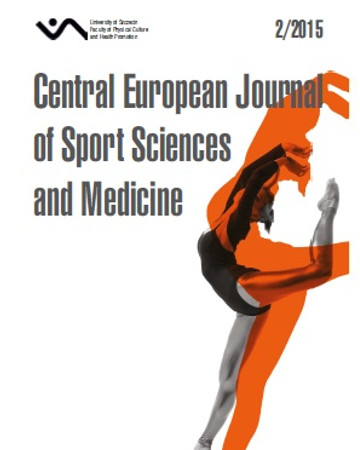
ISSN: 2300-9705
eISSN: 2353-2807
OAI




Lista wydań /
Vol. 10, No. 2/2015
Relationships between Physical Characteristics and Ranking of Young Tennis Players
| Autorzy: |
Ayelet
Dunsky
Life Science Department, Zinman College of Physical Education and Sport Sciences, Wingate Institute, Israel Alon Eliakim Life Science Department, Zinman College of Physical Education and Sport Sciences, Wingate Institute, Israel; Child Health and Sport Center, Pediatric Department, Meir Medical Center, Sackler School of Medicine, Tel Aviv University, Israel Adam Hophy Life Science Department, Zinman College of Physical Education and Sport Sciences, Wingate Institute, Israel Yoav Meckel Life Science Department, Zinman College of Physical Education and Sport Sciences, Wingate Institute, Israel |
| Słowa kluczowe: | tennis fitness speed strength anthropometry endurance |
| Data publikacji całości: | 2015 |
| Liczba stron: | 8 (5-12) |
Abstrakt
The purpose of the present study was: 1) to determine young tennis players’ fitness and anthropometric characteristics; and 2) to determine to what extent these characteristics relate to the players’ national ranking. Forty young (age 15.1 ±0.4) trained male tennis players, who were ranked from 1 to 40 in their age group in the country’s youth tennis players list, were tested for speed, speed endurance, flexibility, strength, specific agility and quickness, aerobic capacity, height, and weight. Significant correlations were found between the players’ ranking and speed (r = 0.430 – 0.475), specific agility and quickness (r = 0.626), speed endurance (r = 0.562), strength (r = –0.416), aerobic capacity (r = –0.581), flexibility (r = 0.352), height (r = –0.443), and weight (r = –0.293). Stepwise regression analysis indicated that specific agility and quickness accounted for almost 40% of the players’ ranking, while its combination with the players’ height accounted for 56%. The results imply the overall importance of anaerobic capabilities and tennis-specific movements to the young tennis players’ ranking. The results also emphasize the importance of tennis-specific tests to the young tennis players’ performance evaluation
Pobierz plik
Plik artykułu
Bibliografia
| 1. | Banzer W., Thiel C., Rosenhagen A., Vogt L. Tennis ranking related to exercise capacity. Br J Sports Med. 2008; 42: 152–154 |
| 2. | Barbaros-Tudor P., Matkovic B., Rupcic T. Morphological characteristics and physiological profile of the Croatian male tennis players. Sports Sci. 2011; 2: 23–27 |
| 3. | Birrer R., Levine R., Gallippi L., Tischler H. The correlation of performance variables in pbenreadolescent tennis players. J Sports Med Phys Fitness. 1986; 26: 137–139. |
| 4. | Chandler T.J. Conditioning for tennis: Preventing injury and enhancing performance. In: Science and racket sports II. Ed. A. Lees. E & FN Spon. London 1998: 77–85. |
| 5. | Chandler T.J., Kibler W.B. Shoulder strength, power, and endurance in college tennis players. Am J Sports Med. 1992; 20: 455–458. |
| 6. | Chandler T.J., Kibler W.B., Uhl T., Wooten B., Kiser A., Stone E. Flexibility comparisons of junior elite tennis players to other athletes. Am J Sports Med. 1990; 18; 134–136. |
| 7. | Dovey P.R., Thorp R.D., Williams C. Fatigue decreases skilled tennis performance. J Sports Sci. 2002; 20: 311–318. |
| 8. | Fernandez J., Mendez-Villanueva A., Pluim B.M. Intensity of tennis match play. Br J Sports Med. 2006; 40: 387–391. |
| 9. | Girard O., Millet G.P. Physical determination of tennis performance in competitive teenage players. J Strength Cond Res. 2009; 23: 1867–1872. |
| 10. | Glaister M. Multiple-sprint work: Physiological responses, mechanisms of fatigue and the influence of aerobic fitness. Sports Med. 2005; 35: 757–777. |
| 11. | Kibler W.B., McQueen C., Uhl T. Fitness evaluation and fitness findings in competitive tennis players. Clin Sports Med. 1988; 7: 403–416. |
| 12. | König D., Huonker M., Schmid A., Halle M., Berg A., Keul J. Cardiovascular, metabolic, and hormonal parameters in professional tennis players. Med Sci Sports Exerc. 2001; 33: 654–658. |
| 13. | Kovacs M.S. Applied physiology of tennis performance. Br J Sports Med. 2006; 40: 381–386. |
| 14. | Lees A. Science and the major racket sports: A review. J Sports Sci. 2003; 21: 707–732. |
| 15. | Perry A.C., Wang X., Feldman B.B., Ruth T., Signorile J. Can laboratory-based tennis profiles predict field tests of tennis performance? J Strength Cond Res. 2004; 18: 136–143. |
| 16. | Reilly T., Benton K.A. Comparison of profiles between county and club female tennis players. In: Science and Racket Sports. Ed. T. Reilly. E & FN Spon. London 1995: 69–71. |
| 17. | Roetert E.P., Garrett G.E., Brown S.W., Camaione D.N. Performance profiles of nationally ranked junior tennis players. J Appl Sports Sci Res. 1992; 6: 225–231. |
| 18. | Signorile J.F., Sandler D.J., Smith W.N., Stoutenberg M., Perry A.C. Correlation analyses and regression modeling between isokinetic testing and on-court performance in competitive adolescent tennis players. J Strength Cond Res. 2005; 19: 519–526. |
| 19. | Smekal G., Pokan R., Von Duvillard S.P., Baron R., Tschan H., Bachl N. Comparison of laboratory and “on-court” endurance testing in tennis. Int J Sports Med. 2000; 21: 242–249. |
| 20. | Smekal G., Von Duvillard S.P., Rihacek C., Pokan R., Hofmann P., Baron R., Tschan H., Bachl N. A physiological profile of tennis match play. Med Sci Sports Exerc. 2001; 33: 999–1005. |
| 21. | St Clair Gibson A., Broomhead S., Lambert M.I., Hawley J.A. Prediction of maximal oxygen uptake from a 20-m shuttle run as measured directly in runners and squash players. J Sports Sci. 1998; 16: 331–335. |
| 22. | Stolen T., Chamari K., Castagna C., Wisloff U. Physiology of soccer: An update. Sports Med. 2005; 35: 501–536. |